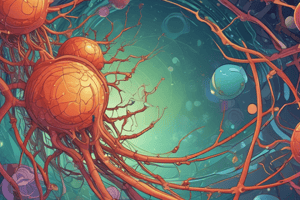Podcast
Questions and Answers
What happens to a majority of effector lymphocytes after a microbe is eliminated?
What happens to a majority of effector lymphocytes after a microbe is eliminated?
- They differentiate into plasma cells
- They die by apoptosis
- They become anergic
- They undergo clonal expansion
What is the role of antibodies secreted by plasma cells?
What is the role of antibodies secreted by plasma cells?
- They promote the phagocytosis and destruction of pathogens (correct)
- They stimulate the activation of lymphocytes
- They inhibit the production of cytokines
- They suppress the immune response
What is the result of immune responses that are normally protective?
What is the result of immune responses that are normally protective?
- Immune tolerance
- Tissue injury (correct)
- Cytokine production
- Antigen presentation
What happens to secreting plasma cells after they migrate to the bone marrow?
What happens to secreting plasma cells after they migrate to the bone marrow?
What is the term for diseases resulting from immune responses that normally are protective?
What is the term for diseases resulting from immune responses that normally are protective?
What is the purpose of the initial activation of lymphocytes?
What is the purpose of the initial activation of lymphocytes?
What is the state of the immune system after the elimination of microbes?
What is the state of the immune system after the elimination of microbes?
What is conferred to neonates by antibodies?
What is conferred to neonates by antibodies?
Which of the following is TRUE about prostaglandin D2 (PGD2)?
Which of the following is TRUE about prostaglandin D2 (PGD2)?
What is the main function of acidic proteoglycans in mast cell granules?
What is the main function of acidic proteoglycans in mast cell granules?
What is the primary action of IL-13 in the context of a TH2-initiated immune reaction?
What is the primary action of IL-13 in the context of a TH2-initiated immune reaction?
What is the role of mast cells in immediate hypersensitivity reactions?
What is the role of mast cells in immediate hypersensitivity reactions?
What is the primary function of ECF in the context of immediate hypersensitivity reactions?
What is the primary function of ECF in the context of immediate hypersensitivity reactions?
What is the role of NCF in the context of immediate hypersensitivity reactions?
What is the role of NCF in the context of immediate hypersensitivity reactions?
What is the primary action of PAF in the context of immediate hypersensitivity reactions?
What is the primary action of PAF in the context of immediate hypersensitivity reactions?
What is the primary function of cytokines in the context of immediate hypersensitivity reactions?
What is the primary function of cytokines in the context of immediate hypersensitivity reactions?
What is the primary effect of systemic vasodilation in an allergic reaction?
What is the primary effect of systemic vasodilation in an allergic reaction?
Which of the following is NOT a type of cytokine?
Which of the following is NOT a type of cytokine?
What is the main role of eosinophils in the late-phase response?
What is the main role of eosinophils in the late-phase response?
What is the outcome of localized allergic reactions in the lung?
What is the outcome of localized allergic reactions in the lung?
What is the primary source of chemokines in the late-phase response?
What is the primary source of chemokines in the late-phase response?
What is the difference between localized and systemic allergic reactions?
What is the difference between localized and systemic allergic reactions?
What is the role of PAF in allergic reactions?
What is the role of PAF in allergic reactions?
What is the time frame for progression to circulatory collapse and death in anaphylactic shock?
What is the time frame for progression to circulatory collapse and death in anaphylactic shock?
What type of hypersensitivity is characterized by the release of TH2 cytokines and the production of IgE antibodies?
What type of hypersensitivity is characterized by the release of TH2 cytokines and the production of IgE antibodies?
Which of the following proteins are toxic to epithelial cells?
Which of the following proteins are toxic to epithelial cells?
What is the term used to describe a familial predisposition to localized type I reactions?
What is the term used to describe a familial predisposition to localized type I reactions?
Which of the following genes are implicated in susceptibility to asthma and other atopic disorders?
Which of the following genes are implicated in susceptibility to asthma and other atopic disorders?
What is the main function of inflammatory leukocytes in immediate hypersensitivity?
What is the main function of inflammatory leukocytes in immediate hypersensitivity?
What is the primary goal of therapy in treating allergic diseases such as asthma and atopic dermatitis?
What is the primary goal of therapy in treating allergic diseases such as asthma and atopic dermatitis?
What is the role of ADAM33 in atopic disorders?
What is the role of ADAM33 in atopic disorders?
What is the relationship between type I hypersensitivity and human disease?
What is the relationship between type I hypersensitivity and human disease?
What is the name of the pathological lesion that occurs in blood vessels?
What is the name of the pathological lesion that occurs in blood vessels?
What is the result of antibody-coated cells being phagocytosed by macrophages?
What is the result of antibody-coated cells being phagocytosed by macrophages?
What type of antibodies are capable of inducing lesions?
What type of antibodies are capable of inducing lesions?
What is the result of the interactions between immune complexes and leukocytes?
What is the result of the interactions between immune complexes and leukocytes?
What is the term used to describe the lesion that occurs in renal glomeruli?
What is the term used to describe the lesion that occurs in renal glomeruli?
What is the result of the activation of Hageman factor?
What is the result of the activation of Hageman factor?
What is the term used to describe the lesion that occurs in joints?
What is the term used to describe the lesion that occurs in joints?
What is the result of immune complexes depositing in tissues or blood vessels?
What is the result of immune complexes depositing in tissues or blood vessels?
Flashcards are hidden until you start studying
Study Notes
Immune Response and Hypersensitivity Reactions
- Plasma cells secrete antibodies that neutralize microbes, block their infectivity, and promote phagocytosis and destruction of pathogens.
- Antibodies also confer passive immunity to neonates, and Immunologic Memory is generated.
Decline of Immune Responses
- After an infectious pathogen is eliminated, most effector lymphocytes die by apoptosis, returning the immune system to its basal resting state.
- This return to homeostasis occurs because microbes provide essential stimuli for lymphocyte survival and activation.
- Activated lymphocytes are no longer kept alive as the stimuli are eliminated.
Hypersensitivity Reactions
- Immune responses can cause tissue injury, resulting in hypersensitivity diseases.
- Hypersensitivity reactions are grouped into several categories, including immediate hypersensitivity reactions.
- Immediate hypersensitivity reactions involve IgE antibodies and are responsible for allergic reactions.
Immediate Hypersensitivity Reactions
- Mast cells synthesize and secrete prostaglandins and leukotrienes, which have several actions important in immediate hypersensitivity reactions.
- These lipid mediators can cause intense bronchospasm, increased mucus secretion, and promote inflammation.
- Eosinophils produce toxic proteins and cytokines that promote inflammation and epithelial cell injury.
Localized Allergic Reactions
- Local reactions occur when the antigen is confined to a particular site, such as skin (contact, causing urticaria), gastrointestinal tract (ingestion, causing diarrhea), or lung (inhalation, causing bronchoconstriction).
- Examples of localized allergic reactions include hay fever, asthma, and certain forms of asthma.
Susceptibility to Hypersensitivity Reactions
- Susceptibility to localized type I reactions has a strong genetic component, and the term atopy is used to imply familial predisposition to such localized reactions.
- Genes implicated in susceptibility to asthma and other atopic disorders include those encoding HLA molecules, cytokines, and ADAM33, a metalloproteinase involved in tissue remodeling in the airways.
Inflammation and Tissue Injury
- Inflammation is a major component of many allergic diseases, notably asthma and atopic dermatitis.
- Therapy usually includes anti-inflammatory drugs such as corticosteroids.
- Leukocytes recruited to the site of inflammation can amplify and sustain the inflammatory response even in the absence of continuous allergen exposure.
- Inflammatory leukocytes are responsible for much of the epithelial cell injury in immediate hypersensitivity reactions.
Studying That Suits You
Use AI to generate personalized quizzes and flashcards to suit your learning preferences.




